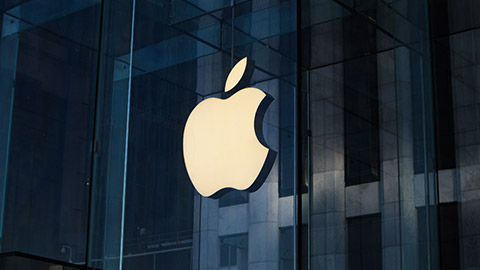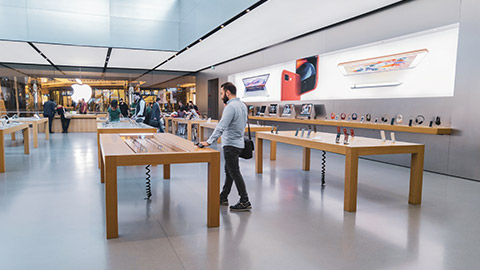Brand
- Gut feeling
- relationships
- expectations
- emotions
- stories
- memories
- behaviour
Identity
- Stationery
- collateral
- signage
- positioning
- messaging
- colour system
- fonts
Logo
- Symbols
- words
- colour
- shape
- form
What's the difference?
A company or a designer cannot directly create a brand. The brand is consumer-driven and represents the consumer and company relationship.
Over time, this relationship is built using promises, experiences, and memories.
Another way to describe a brand is a company's 'personality', which is created by the audience's perceptions.
A quote from Jeff Bezos, founder of Amazon, which explains the term 'brand' well is,
Your brand is what people say about you when you are not in the room
- Consumer driven
- Promises
- Memories
- Relationship
- Experiences personality

Apple's brand
Consumers may describe their view on Apple with words such as trust, lifestyle, beautiful design, and loyalty.
Identity: Sensory and visual consistency
A company's identity is its sensory devices, which the audience comes into contact with. This includes consistency with business stationery, marketing materials, emails, signage, office/shop space, uniforms etc.
- Sensory
- Visual
- Consistency

Apple’s identity
Apple's identity could be seen as its visual consistency with the recognisable blue t-shirt worn by staff, store designs (glass, light wood, bright), and product shape and colours (curves, silver, white, black).
Logo: Brand and identity simplified to an identifiable mark
The logo is the identity and brand, all symbolised with an identifiable mark. A logo doesn't have to describe what a company does and tends to work best after becoming more familiar over time. For instance, once a name has been used to identify someone over time, it becomes memorable, even though their name does not describe their personality.
- Icon
- Symbol
- Wordmark
- Identifies company in its simplest form.
Apple's logo
Although an apple does not directly describe what the company does, it has over time become a recognisable icon for the company. However, the Apple logo has some hidden aspects, such as the bite in the apple relating to the computer term - byte. The main thing is that even though there have been slight changes, the logo has remained the same shape for nearly 40 years, and it is consistency that has created a recognisable symbol.

Five key principles
By creating a solid logo, consumers can remember a brand and cultivate positive associations with it. They become embedded in memories and emotions to help consumers connect to the brand and the products/services.
1. Simple
A simple logo design allows for easy recognition and allows the logo to be versatile and memorable. Good logos feature something unique without being overdrawn.
2. Memorable
Following closely behind the principle of simplicity is that of memorability. An effective logo design should be memorable, and this is achieved by having a simple, yet appropriate logo.
3. Timeless
An effective logo should be timeless—that is, it will endure the ages. Will the logo still be effective in 10, 20, 50 years? Leave trends to the fashion industry—Trends come and go, and when you're talking about changing a pair of jeans, or buying a new dress, that's fine, but where your brand identity is concerned; longevity is critical. Don't follow the pack. Stand out.

4. Versatile
An effective logo should work across a variety of mediums and applications. The logo should be functional. For this reason, a logo should be designed in vector format to ensure that it can be scaled to any size. The logo should be able to work both in horizontal and vertical formats.
5. Appropriate
A professional logo should be functional. The logo must be relevant to the target market. A logo for a toy store, for example, could be bright and cheerful, but this would not be the case for a law office.
Any brand development is an investment for companies and will involve a step-by-step process. The level of depth to this process depends on the company's project, budget, and goal.
The following stages will outline the different skills involved with developing a brand – including creating a new brand, refreshing or updating brands.
- Conducting research
- Formulating a brand strategy
- Creative execution: naming and logo
- Creative implementation advertising and digital presence
- Communicating the brand.
Conducting research
Building a brand requires business acumen and design thinking. The priority is to understand the organisation: it's mission, vision, values, target markets, corporate culture, competitive advantage, strengths and weaknesses, marketing strategies, and challenges for the future.
Understanding comes from various sources, and requesting the correct information from the client:
- Reading strategic documents
- Business plans to interview key stakeholders.
Formulating a brand strategy
A brand strategy is critical to determine the direction for the brand. This may be managed 'in-house' (within the company) or done with an agency or brand consultant. As a general guide, it is often the branding agency, or lead marketing agency, that helps create a brand strategy.
A strategy should detail areas such as understanding the brand's audience and its market (including competitors) and integrating with its vision.
A company may also commission research into the audience's needs and experiences of the brand.
Creative execution: naming and logo
The strategy will feed into the brand development stage, which involves creating a look and feel for the brand, including the brand language (often referred to as its 'tone of voice') and the logo and name.
An entire rebrand such as a name or logo change may not be necessary but changing the visual aspects of the brand can reinvigorate or modernise it. This stage of the branding process tends to be carried out by the branding agency, with designers and writers as part of the team.

Creative implementation: advertising and digital presence
Brand implementation will involve advertising and design agencies.
Advertising agencies still play a powerful role in brand execution, often working in long-term collaborations with companies. In many cases, the ad agency will 'own' the brand's execution – the part visible on billboards, TV and in print.
Design agencies are often crucial to the brand implementation process – and many smaller design agencies will do the full brand implementation, from concept to development. Some specialise in executing the brand online, which can involve a full brand translation to the digital sphere, with strategy and a creative process to ascertain how a brand should look, feel and communicate online.
The digital presence of a brand is now as important as traditional advertising in the brand execution process.
Communicating the brand
A critical part of brand execution is defining how to communicate the brand best. Branding agencies should play a key role here by developing a communications plan for the brand's ongoing presence. Some public relations agencies also specialise in this area. A communications strategy should cover both the employee and external communications execution for the brand
| Core brand elements | |
|---|---|
| Core Purpose | The reason the company exists beyond making a profit |
| Vision | The story a leader tells to explain "how" a company will achieve its mission |
| Values | Core cultural beliefs and philosophies |
| Personality | Brand tone and voice for receptivity and resonance |
| Capabilities & features | The measure of the ability of the brand to achieve its mission |
| Core competencies | A cluster of related abilities, commitments, knowledge, and skills that enable a brand to perform effectively |
| Competition | Points of parity and difference |
| Target audience | The addressable population, focusing on decision-makers |
| Needs and objections | Needs: Unmet needs we hope to fulfil Objections: Top reasons audience may reject us or not act |
| Big idea/brand essence | Evergreen, differentiating phrase that provides inspiration and focus |
| Value proposition | Set of functional, emotional, and social benefits (how we fulfil audience needs) |
| Proof points | Why should they believe we do this best? Why should they act? |
| Desired outcome | In consumer language, a single statement most desired from stakeholders |
Our brand identity- our logo, our voice, our design – Is an important signal of what we believe in and what we do. We have designed the language of the internet into our brand identity.
A national entertainment brand, MD entertainment, has seen a decline in engagement with its traditional audience in recent months. They are looking to appeal to and attract a youthful market through a range of dynamic and exciting promotional material. They have tasked you with looking at their current brand strategy and promotional material to then pitch a new and exciting strategic and visual direction for the following year.
Research their current target audience, the media and production methods that are being used to engage with them to inform your development of a small range of new touch- points such as a logo and deliverables to revitalise the brand engagement.
Share your findings in the forum with your peers.


